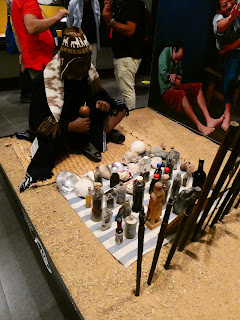The main reason I had for returning to Peru once again was to visit the northern coastal area of the country, home to the ancient Moche, Sican, Chimu cultures. All of these preceded the Inca conquest. In fact, the Inca barely made it to the northern shore before the Spanish arrived. Here is a link to information on the Moche culture of the Northern Coast.
Since this is a coastal area and a giant flood plain created by debris washed down from the Andes Mountains during rainy seasons, there is no building material per se. So all of the sacred temples, or huacas, were constructed of mud bricks. The terrain is relatively flat and green. We drove through fields of sugar cane, corn, and rice. Every once in a while, one could see what appeared to be a small mountain that was sandy colored and badly furrowed by erosion. These were the huacas, which were ceremonial sites and burial grounds of the elite.
We visited
several of these. We first toured
through either the ceremonial areas of the site, or the actual tombs of the
elite that had been buried there. The
tombs had been reconstructed so that one could see how that person was buried. They were also deep underground.
The ceremonial sites of the Moche featured themes of conquest of their enemies and ceremonial or non ceremonial sacrifices of humans and an occasional llama. Their god was “The Decapitator”. That should tell you a lot! I could feel the heavy energy of the activities that took place there.
Then, each site had a museum that housed the actual artifacts that were removed from the tombs. Lots of golden objects, adornments of shells and semi precious stones, fine carvings, and jewelry. Here is a necklace that I'd love to have!
In 1987, the tomb of the Lord of Sipan was discovered. Some say that this was the greatest archaeological discovery of the 20th century. It was fabulous, but I would vote for King Tut! Below is a statue of the Lord of Sipan in his ceremonial garb. Here is a link if you want to learn more.
After a while, going through museum after museum, it all became a blur. One very interesting display at one of the last museums that we went through showed a San Pedro cactus healing ceremony. That brought back memories of my shamanic training. The shaman spreads out his blanket and arranges all of his healing tools and potions on it. At the opposite end of the blanket, he lines up several swords that are stuck straight into the ground. The client stands behind the swords.The shaman and the client both drink the San Pedro, so both are in an altered state during the healing. As the shaman chants, he can see an energetic connection go out from himself and through one after the other of his healing tools and ending up at one of the swords. Then that sword starts to sway forwards and backwards. He then completes the healing using the objects on his blanket that were indicated.
We visited a site called “El Brujo”, the witch, where the Senora de Cao’s tomb was found. She was the highest status female burial ever found in Peru. This huaca was right by the ocean, and was pretty eroded.This is Chan
Chan, a huge site that was the capital of the Chimu Kingdom, which reached its
apogee in the 15th century, not long before falling to the Incas. It was the
largest earthen architecture city in pre-Columbian America. Here is a link for more on Chan Chan.
One big surprise for me was the presence of burrowing owls at many of the sites. In the United States, these owls live mostly in abandoned prairie dog burrows in the summer, and then they migrate south in the winter. There in Peru, they were permanent residents and did not migrate. They nest in cavities in the ruins, and sometimes dig their own. Apparently when I was there, it was their mating season. We saw lots of fighting and chasing among the owls. It was quite entertaining! In fact, at one site, there was so much of that going on that no one really listened to the local guide giving his talk.
So there you have it. More to come!


















No comments:
Post a Comment